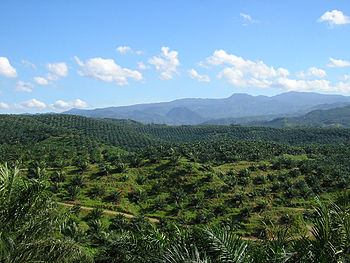
Palm oil production is important to the economy of Indonesia as the country is the world's biggest producer and consumer of the commodity, providing about half of the world's supply.[1] In 2016, Indonesia produced over 34.6 million metric tons (34,100,000 long tons; 38,100,000 short tons) of palm oil, and exported 25.1 million metric tons (24,700,000 long tons; 27,700,000 short tons) of it. Oil palm plantations stretch across at least 12 million hectares (30 million acres). There are several different types of plantations, including small, privately owned plantations, and larger, state-owned plantations.[2] There are a variety of health, environmental, and societal impacts that result from the production of palm oil in Indonesia. A recent publication by the NGO Rainforest Action Network (RAN) indicates that the use of palm oil by some of the biggest chocolate and snacks' producers is increasing this problem.[3]
In addition to servicing traditional markets, Indonesia is looking to put more effort into producing biodiesel. China and India are the major importers of palm oil, accounting for more than a third of global palm oil imports. Looking at Indonesia's GHG emissions breakdown, climate change mitigation will mainly come from controlling forest fires and peatland conservation. REDD+ (Reducing Emissions from Deforestation and Forest Degradation in Developing Countries) will be ‘an important component of the NDC target from [the] land-use sector’.[4] This implies that there will need to be large economic incentives and inputs from outside resources to ensure that land-use change is prevented.
- ^ McClanahan, Paige (11 September 2013). "Can Indonesia increase palm oil output without destroying its forest? Environmentalists doubt the world's biggest palm oil producer can implement ambitious plans without damaging woodland". The Guardian. Retrieved 22 September 2013.
- ^ "Indonesia Sumatra Palm Oil Risk Profile". Nepcon.org. 2019. Retrieved 22 March 2019.
- ^ "Os snacks que comemos podem matar orangotangos na Indonésia". Jornal de Notícias. Retrieved 12 November 2019.
- ^ Republic of Indonesia (November 2016). "First Nationally Determined Contribution" (PDF). Retrieved 25 January 2020.